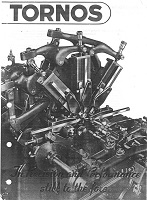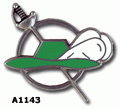|
Osnovni Borbeni Tenk za 21 vek

Najnoviji Ruski osnovni borbeni tenk (MBT) nazvan Chiorny Oriol (Crni orao) prikazan je po prvi puta na drugoj VTTV-Omsk-97 Medjunarodnoj Izlozbi Naoruzanja, Vojne Opreme i Konverovane Opreme koji je zavrsio ranog Septembra u Osku, Sibir, Russia. Demonstracija tenka izvodila se na 500 metara distanci od gledalista. Tokom demonstracije, tenkovska kupola, cev i sistem naoruzanja pazljivo je zamotan, prekriven.
Sef glavne oklopne komande Ruske Federacije, General-pukovnik Sergei Mayev, i zamenik direktora 'Rosvoorouzhenie kompanije', Sergei Bukharov, koji su napravili inspekciju tenka iz blizine na terenu Omsk Transport Machinebuilding Plant (OTMP), odbili su komentar o njegovim karakteristikama.

Iz pouzdanih izvora od strane strucnjaka, saznaje se da Crni Orao je rezultat radikalnog preuredjenja T-80U MBT izvrsenog pod direkcijom dizajnera Generala Borisa Kurakina. Selekcija T-80U kao baza za razvoj pete generacije MBT-a proizlazi iz cinjenice da je ispravno tvrditi kako je 'ORLIC' trenutno najbolji osnovni teskas na svetu, koji uspesno kombinuje sve osnovne perfomanse okarakterisane u: brzini, manevarskim sposobnostima, vatrena moc i sistem zastite oklopa/posade.

Chiorny Oriol ima u globalu dimenzije iste kao i T-80U, ali i nizu siluetu sto ga cini manje uocljivim na vatrenoj liniji. Strucnjaci veruju da kombinovanjem osnovnih perfomansi kao sto su manevar, vatrena moc, proboj neprijateljskog oklopa i vlastite zastite ovaj MBT prelazi zapadne MBT-e (MAIN BATTLE TANK) kao sto su M1A2 Abrams, Leclerk i Leopard-2 u odnosu 1.5 - 1.7. za "ORLICA".


Tekst u engleskoj verziji -
In late 80s, the design bureau of Leningrad Kirov Plant (LKZ) under the leadership of Nikolai Popov developed a design of a brand-new tank based on a stretched and redesigned T-80U chassis. Following the closure of the bureau the documentation has been transferred to Omsk which became the main maintainer of T-80 line of MBTs. The development of this project, designated in Omsk Obiekt 640, has continued.
At the second VTTV-Omsk-97 International Exhibition of Armaments, Military Equipment and Conversion Products held in September '97 in Omsk, Siberia region, Russia, the prototype was first shown to the public, under the catchy name Chiorny Oriol (Black Eagle). Back then, this was nothing more than a full-sized turret mockup mounted on a production T-80U hull. Despite the fact that the turret was concealed beneath the camo netting, it was immediately obvious that its design represented a radical departure from the traditional Soviet designs. This vehicle has generated considerable excitement and various hypotheses were floated ranging from it being a new vehicle for the Russian Armed Forces to it being a purely export development.
Until recently, there were hardly any details about the tank except for a couple of words and a poster on the Defendory 1998 held in Greece, but lately considerable amount of information has been revealed, probably due to the fact that Omsk Transmash bureau is desperate to break through the pro-UVZ lobby and turn around the grim prospects of the Omsk tank-building complex (which is in the state of bankruptcy management since 2002).
It seems reasonable to assume that Omsk will face an uphill battle in bringing the tank to production. This is unfortunate as it is certainly an innovative design that brings some fresh air into the stagnating Russian tank design school.
The tank has the following important innovations compared to Soviet-school tanks:
* Stretched hull with 7 road-wheels per side, allowing to increase the thickness of the glacis armor array and move the driver's hatch farther to the rear thereby eliminating the weakened area around driver's optics present on Soviet tanks.
* The bustle-mounted high-capacity ammo magazine/autoloader that allows high rate of fire, fast automated ammo replenishment, eliminates main survivability issue with Soviet tanks, and reduces the height of the tank by 400mm compared to T-80U (allowing increased front armor density).
* Placement of the armament in a separate compartment with provisions for the installation of a wide range of different mainguns (up to 152mm) without the need for heavy redesign.
* Placement of each crewmember in a separate compartment, thereby limiting the crew casualties in case of penetration.
* Very sloped frontal armor with high degree of protection uniformity over a variety of angles.
* Thick turret roof with multilayered armor to counter top-attack threats.
Dimensions (mm) L7,000+? x W3,582 x H1,800(?) x 451 clearance
Weight: 50.0? metric tons
Crew: 3
Engine: Several options of diesel or turbine engines up to 1,500 hp
Max Road Speed: ? km/h
Max X-country Speed: ? km/h
Power/Weight: 25-30 hp/tn
Ground Pressure: ? kg/sq.cm
Range: ? km
Obstacle negotiation:
Fording depth: ? m
Trench width: ? m
Vertical obstacle: ? m
Maximum gradient: ?°
Weapons:
Main Weapon:
125mm 2A46M smoothbore
provision for installing other systems up to 152mm
Rate of fire: Over 12 rounds/min
Ammunition: 30 125mm rounds in the autoloader
backup ammo storage unknown
Ammunition Types: APFSDS, HEAT, HEF ATGM through main gun
Auxiliary armament: UNKNOWN
Equipment: UNKNOWN
Armor rating, mm RHA: Front turret 107..116cm vs APFSDS; 159..171cm vs HEAT
Glacis UNKNOWN
|


























